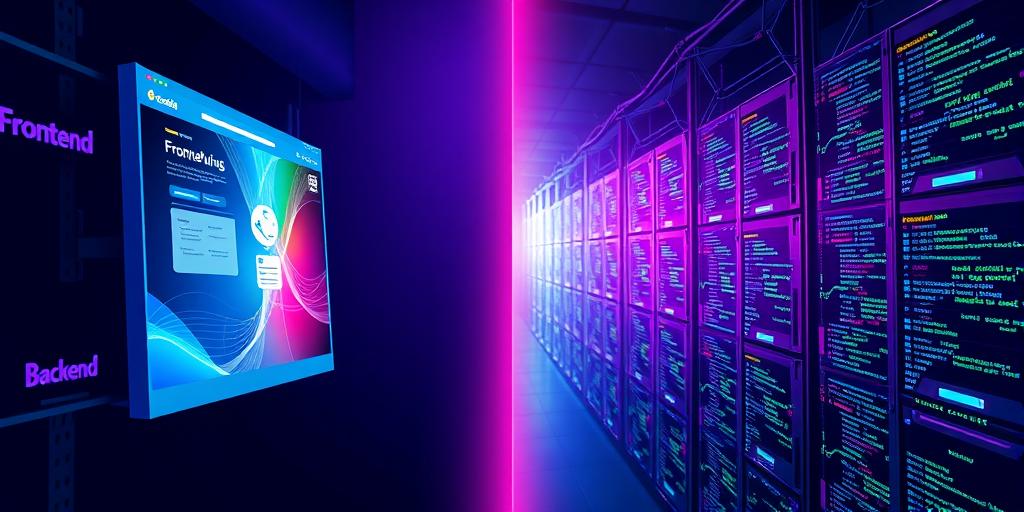Want to learn the difference between frontend and backend development? This isn’t some arcane developer magic; it’s the fundamental division of labor in the digital world. We’re talking about the visible vs. invisible, the interactive vs. the engine—the parts you see and use directly against the inner workings that make it all tick. So, grab your keyboard (or just your attention!), because we’re about to dive deep into the fascinating world of frontend and backend development. Let’s unpack these concepts so you can grasp the core distinctions and maybe even discover your next career passion!
Understanding Frontend Development: The Face of the Web
Frontend development is all about the user interface (UI) and user experience (UX). Think of it as the glamorous, outward-facing aspect of a website or application. It’s what users see, interact with, and engage with directly. This includes everything from the layout and design, buttons, images, and navigation menus. It involves bringing an app’s design to life. The visual appeal of a website, how smooth its functionality is, and how intuitive it is to navigate are all determined by the frontend developers. They make sure the user journey is seamless and satisfying, turning lines of code into a visually stunning and effective experience.
Core Technologies of Frontend Development
Frontend development typically employs HTML, CSS, and JavaScript. HTML provides the structure, CSS styles the look and feel, and JavaScript adds interactivity and dynamic behavior. Frameworks and libraries such as React, Angular, and Vue.js further streamline and enhance the development process, adding elements of organization and efficiency. Mastering these technologies is key to creating elegant and functional user interfaces.
The Role of Frontend Developers
Frontend developers are responsible for transforming designs into functional code. They collaborate with designers, ensuring the technical feasibility of design ideas and translating the designs into interactive web pages or application interfaces. They also test the functionality and user experience, performing debugging to identify and fix bugs and ensuring the site works seamlessly across various browsers and devices.
Delving into Backend Development: The Powerhouse Behind the Scenes
Backend development, in contrast, deals with the server-side logic and database management of an application. It’s the hidden powerhouse, the unseen infrastructure ensuring the frontend’s smooth operation. While users don’t directly interact with the backend, it’s the core that facilitates data processing, storage, and retrieval. It’s the part of the application where data is handled, stored, processed, and moved, ultimately controlling the functionality users see.
Core Technologies of Backend Development
Backend development often involves various programming languages (like Python, Java, PHP, Node.js, Ruby on Rails), databases (such as MySQL, PostgreSQL, MongoDB), and servers. These technologies work together to handle data requests from the frontend, process that data, and return the appropriate response back to the frontend for display. It requires a strong grasp of data structures, algorithms, and database management.
The Role of Backend Developers
Backend developers work on the server-side logic, databases, and APIs that power web applications. They are responsible for ensuring data security, scalability, and reliability. They implement the business logic, determine how data is stored and manipulated, and ensure the application performs efficiently under heavy load. They also write APIs that allow communication between the frontend and backend.
Frontend vs. Backend: Key Differences Summarized
| Feature | Frontend Development | Backend Development |
|—————–|—————————————————–|——————————————————-|
| User Interaction | Direct | Indirect |
| Focus | User interface (UI) and user experience (UX) | Server-side logic, databases, and APIs |
| Technology | HTML, CSS, JavaScript, React, Angular, Vue.js | Python, Java, PHP, Node.js, Ruby on Rails, Databases |
| Visibility | Visible to the user | Hidden from the user |
| Example | Layout design, interactive elements, animations | Data processing, user authentication, database queries |
Bridging the Gap: The Full-Stack Developer
While distinct, frontend and backend development are not mutually exclusive. Full-stack developers possess expertise in both areas, enabling them to work across the entire application stack. These individuals are exceptionally valuable, as they understand all facets of application development. They can efficiently handle the design, development, and deployment processes, offering a comprehensive approach that minimizes the need for extensive collaboration between separate teams. This makes them an asset for both small and large projects.
Ready to launch your career in web development? Understanding the differences between frontend and backend is just the first step! Explore our comprehensive courses today and start building your dream applications!

